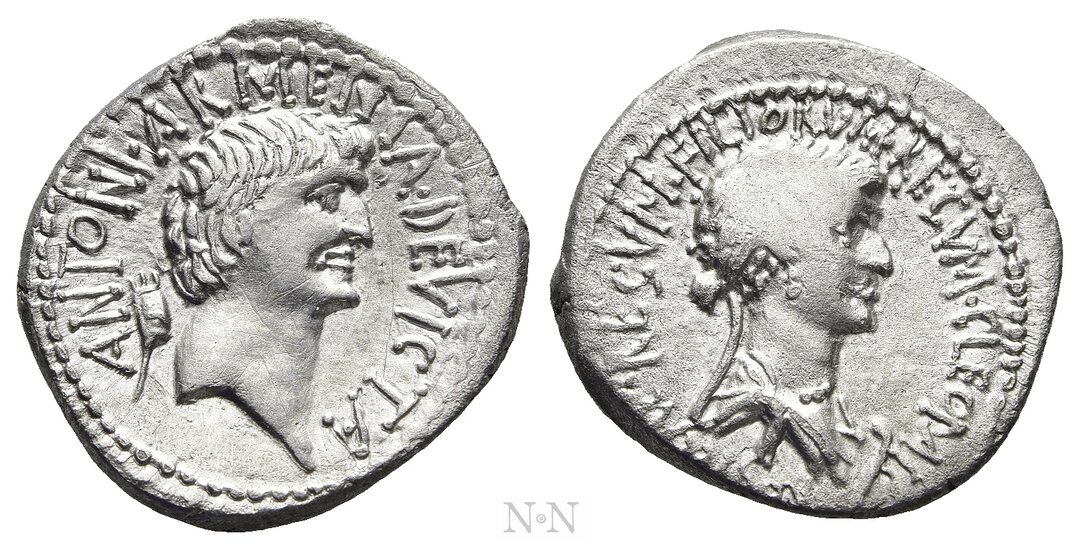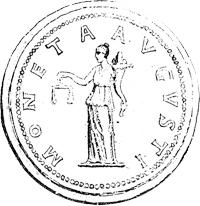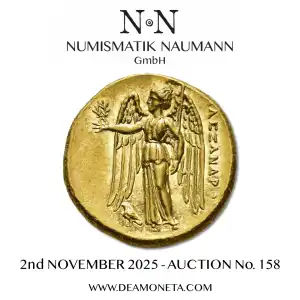Cleopatra´s Portrait




MARK ANTONY and CLEOPATRA (34 BC). Denarius. Military Mint traveling with M. Antony.
Obv: ANTONI ARMENIA DEVICTA.
Bare head of Mark Antony right; Armenian tiara to left.
Rev: CLEOPATRAE REGINAE REGVM FILIORVM REGVM.
Diademed and draped bust of Cleopatra right; to lower right, prow right.
Crawford 543/1; CRI 345; RBW 1832.
Cleopatra VII, the last queen of the Ptolemaic dynasty in Egypt, was described by sources as an excellent political strategist, clever and cultured. She was always committed to maintaining the independence of her kingdom in the face of the growing threat of Roman expansion and knew how to use her charisma to build alliances and consolidate her power, first with Caesar and then with Antony. Her union with Antony was not only a bond of love, but also a strategic alliance that aimed to strengthen the positions of both against internal and external enemies. They met officially for the first time in 41 BC, when Antony, eager to strengthen his position in the East, summoned the queen to Tarsus. Cleopatra, trying to impress the Roman general, arrived in the city with a lavish procession, displaying all the symbols of Egyptian power and wealth. The queen presented herself as the reincarnation of Isis, using a symbolic and cultural strategy that deeply fascinated Antony. Antony then followed Cleopatra to Egypt, where he spent several months at her side, strengthening their bond. Their relationship scandalized Rome, where it was considered inappropriate for a Roman general to be influenced by a foreign queen, especially at a time of political crisis. The bond between Antony and Cleopatra grew even stronger when their children, Alexander Helios and Cleopatra Selene, were born, symbolizing the alliance between Rome and Egypt. However, tensions with Rome were mounting: Octavian, eager to consolidate his power, used their relationship to paint Antony as a traitor, accusing him of wanting to divide the Empire to create an eastern kingdom with Cleopatra. This denarius was struck in 34 BC when Antony, returning from his campaign in Armenia, celebrated his triumph with the entire royal family in Alexandria. Cleopatra, who had already received substantial concessions and territories, was proclaimed queen of Egypt, Cyprus, Libya, and part of Syria. Her son Ptolemy XV (Caesarion) was associated with his mother in the government of these territories with the title of “King of Kings.” The sons she had with Antony received Armenia, the territories of the Parthians, Cyrenaica, Libya, and Cilicia. The legend on this coin names Cleopatra “REGINAE REGUM [MATRI] FILIORUM REGUM” (= Queen of Kings and of her Sons, being Kings). The portrait of Antony is associated with the Armenian crown, recalling the victory achieved and the triumph over Armenia. In 32 BC, tensions between Antony and Octavian erupted into open conflict. Cleopatra sided with Antony, supporting him with troops and resources, and the two fought together in the Battle of Actium in 31 BC. However, the battle ended in disastrous defeat for the pair, who were forced to retreat to Alexandria. In 30 BC, when Octavian's troops arrived at the gates of Alexandria, Antony took his own life. Cleopatra, captured by Octavian, attempted to negotiate the safety of her children and her kingdom, but soon realized that she would be taken to Rome as a prisoner and chose to take her own life, probably with the poison of an asp.
Condition: Very fine.
Weight: 3.41 g.
Diameter: 19 mm.
Obv: ANTONI ARMENIA DEVICTA.
Bare head of Mark Antony right; Armenian tiara to left.
Rev: CLEOPATRAE REGINAE REGVM FILIORVM REGVM.
Diademed and draped bust of Cleopatra right; to lower right, prow right.
Crawford 543/1; CRI 345; RBW 1832.
Cleopatra VII, the last queen of the Ptolemaic dynasty in Egypt, was described by sources as an excellent political strategist, clever and cultured. She was always committed to maintaining the independence of her kingdom in the face of the growing threat of Roman expansion and knew how to use her charisma to build alliances and consolidate her power, first with Caesar and then with Antony. Her union with Antony was not only a bond of love, but also a strategic alliance that aimed to strengthen the positions of both against internal and external enemies. They met officially for the first time in 41 BC, when Antony, eager to strengthen his position in the East, summoned the queen to Tarsus. Cleopatra, trying to impress the Roman general, arrived in the city with a lavish procession, displaying all the symbols of Egyptian power and wealth. The queen presented herself as the reincarnation of Isis, using a symbolic and cultural strategy that deeply fascinated Antony. Antony then followed Cleopatra to Egypt, where he spent several months at her side, strengthening their bond. Their relationship scandalized Rome, where it was considered inappropriate for a Roman general to be influenced by a foreign queen, especially at a time of political crisis. The bond between Antony and Cleopatra grew even stronger when their children, Alexander Helios and Cleopatra Selene, were born, symbolizing the alliance between Rome and Egypt. However, tensions with Rome were mounting: Octavian, eager to consolidate his power, used their relationship to paint Antony as a traitor, accusing him of wanting to divide the Empire to create an eastern kingdom with Cleopatra. This denarius was struck in 34 BC when Antony, returning from his campaign in Armenia, celebrated his triumph with the entire royal family in Alexandria. Cleopatra, who had already received substantial concessions and territories, was proclaimed queen of Egypt, Cyprus, Libya, and part of Syria. Her son Ptolemy XV (Caesarion) was associated with his mother in the government of these territories with the title of “King of Kings.” The sons she had with Antony received Armenia, the territories of the Parthians, Cyrenaica, Libya, and Cilicia. The legend on this coin names Cleopatra “REGINAE REGUM [MATRI] FILIORUM REGUM” (= Queen of Kings and of her Sons, being Kings). The portrait of Antony is associated with the Armenian crown, recalling the victory achieved and the triumph over Armenia. In 32 BC, tensions between Antony and Octavian erupted into open conflict. Cleopatra sided with Antony, supporting him with troops and resources, and the two fought together in the Battle of Actium in 31 BC. However, the battle ended in disastrous defeat for the pair, who were forced to retreat to Alexandria. In 30 BC, when Octavian's troops arrived at the gates of Alexandria, Antony took his own life. Cleopatra, captured by Octavian, attempted to negotiate the safety of her children and her kingdom, but soon realized that she would be taken to Rome as a prisoner and chose to take her own life, probably with the poison of an asp.
Condition: Very fine.
Weight: 3.41 g.
Diameter: 19 mm.


